Table of Contents
Landing your dream architecture job starts long before the interview. It begins with a resume that captures attention in seconds. In an industry where creativity meets technical precision, your resume needs to demonstrate both your design sensibility and your professional capabilities to stand out in the competitive job market.
It needs to be visually appealing, well-structured, and communicate your value proposition clearly. Just as you wouldn’t submit a cluttered floor plan to a client, you shouldn’t present a disorganized resume to a potential employer.
This comprehensive guide walks you through every essential element of creating an outstanding architecture resume, from crafting compelling professional summaries to optimizing for applicant tracking systems.
Why Do Architects Need a Strong Resume?
Your resume is often your first, and sometimes only, chance to make an impression. In a competitive field like architecture, where firms may receive hundreds of applications for a single position, a strong resume isn’t just helpful; it’s essential.
Your resume serves multiple critical functions:
- Creates your professional first impression before anyone sees your portfolio or hears your design philosophy
- Demonstrates your communication skills by distilling complex information into clear, compelling content
- Shows you understand industry standards through proper formatting and relevant technical details
- Helps you pass digital screening through applicant tracking systems that filter most resumes
- Opens doors to unexpected opportunities when hiring managers remember standout candidates
Think of your resume as the foundation of your job search. Just as a building needs a solid foundation to support everything above it, your career advancement needs a strong resume to support your portfolio, interviews, and professional growth.
What Do Architecture Firms Look for in a Resume?
Understanding what firms prioritize helps you structure your resume strategically. While every firm has unique preferences, most share common priorities when evaluating candidates.
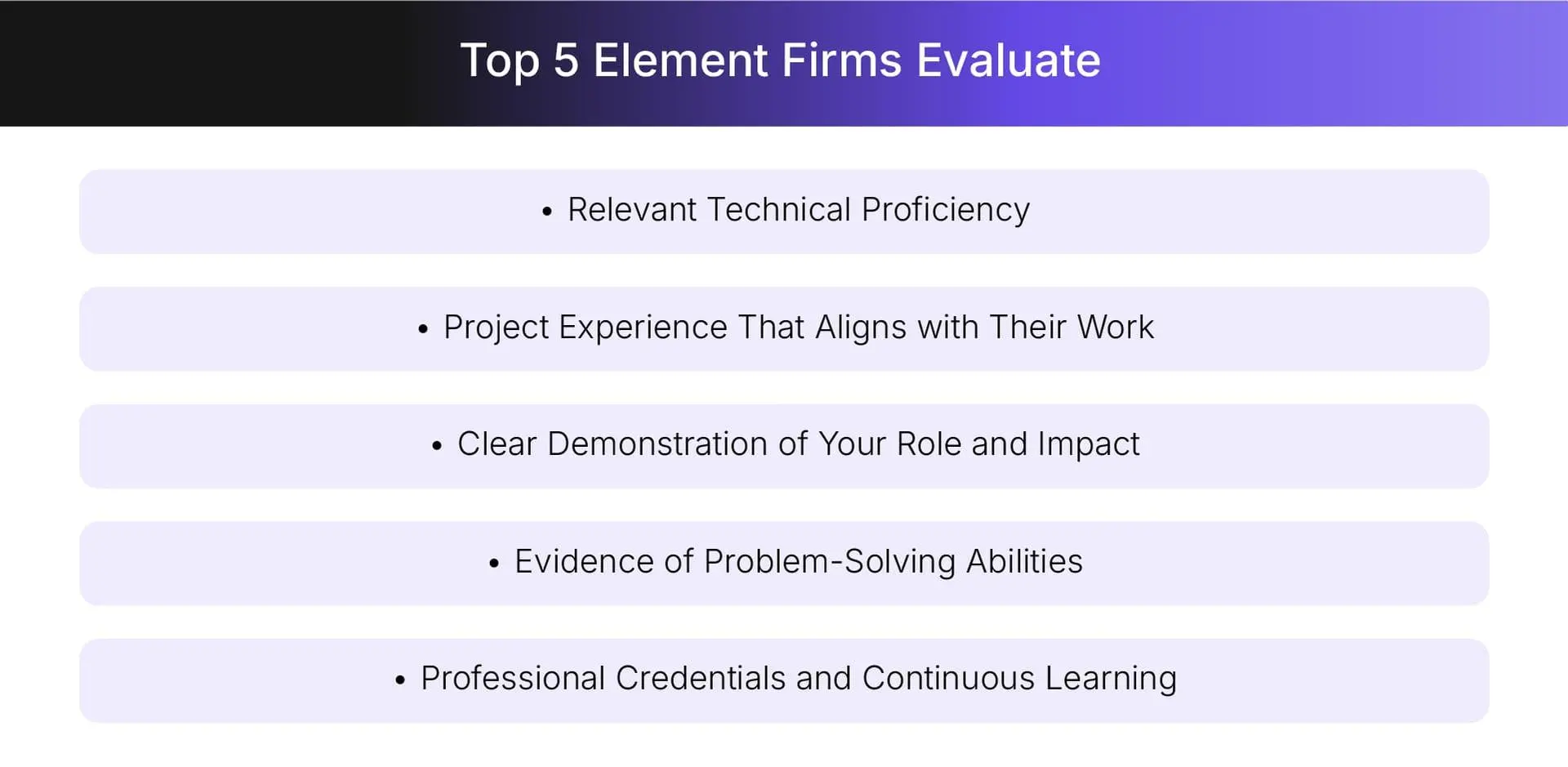
Firms want to see specific architecture software skills – AutoCAD, Revit, SketchUp, Rhino, Adobe Creative Suite, and BIM platforms.
2. Project Experience That Aligns with Their Work
A firm specializing in sustainable commercial buildings cares more about your LEED-certified office complex and experience using sustainable materials than your residential remodeling projects. Review the firm’s portfolio before applying and emphasize similar work.
3. Clear Demonstration of Your Role and Impact
Firms don’t just want to know what projects you worked on, they want to understand what you specifically contributed. “Led schematic design phase” and “Reduced project timeline by 15%” tell stronger stories than “Worked on various projects.”
4. Evidence of Problem-Solving Abilities
Architecture is fundamentally about solving problems within constraints. Firms look for examples demonstrating your analytical thinking and creative solutions to site challenges, code requirements, or client needs.
5. Professional Credentials and Continuous Learning
Licensure status matters tremendously. LEED AP, NCARB certification, or specialized training in sustainable design demonstrate commitment to professional development beyond basic job requirements.
With these priorities in mind, let’s break down the specific sections you need to include in your architecture resume to meet these expectations.
What Should You Include in Your Architecture Resume?
A comprehensive architecture resume contains several key sections, each serving a specific purpose in presenting your qualifications.
How Do You Write a Professional Summary for an Architecture Resume?
Your professional summary is your elevator pitch, a 3-4 sentence paragraph at the top of your resume that immediately tells hiring managers who you are and why you’re worth their time.
Essential elements of a strong summary:
1. Professional identity and experience level: “Licensed architect with 8 years of experience in sustainable commercial design”
2. Area of specialization: Healthcare facilities, adaptive reuse, parametric design, etc.
3. Most impressive quantifiable achievement: “Led 15+ LEED-certified projects valued at $75M+”
4. What you’re seeking or what value you bring: Connect your experience to the role you want
Example Summaries by Career Stage:
1. Experienced Architect
Licensed architect with 10+ years specializing in institutional and educational facilities. Led design teams for 20+ K-12 school projects totaling $120M in construction value, with 5 projects receiving AIA design awards. Expert in collaborative design processes and stakeholder engagement. Proficient in Revit, AutoCAD, and SketchUp with LEED AP credential.
2. Mid-Career Architect
Architectural designer with 5 years of work experience in high-end residential and boutique commercial projects. Managed 8 projects from schematic design through completion with 100% client satisfaction rate. Strong technical skills in Revit and sustainable design integration. Seeking licensure while contributing to design-focused firms valuing craftsmanship.
3. Entry-Level/Recent Graduate
Recent Master of Landscape Architecture graduate with honors from [University] and 18 months of internship experience at award-winning urban planning design firms. Contributed to competition-winning mixed-use development and assisted on construction documentation for an $8M residential project. Proficient in Revit, Rhino, V-Ray, and Adobe Creative Suite.
Once you’ve captured attention with your summary, the next step is demonstrating your capabilities through your work experience.
How Should You List Your Architecture Work Experience?
Your work experience section is the heart of your resume. The way you structure and describe your experience can dramatically impact how impressive your background appears.
Structure each position properly:
Start with your job title, followed by the company name and location, then dates of employment. Include 3-6 bullet points describing your responsibilities and achievements. Each bullet should demonstrate impact, not just duties.
Use strong action verbs to begin each bullet point:
| Design Verbs | Leadership Verbs | Technical Verbs | Collaboration Verbs |
| Designed | Led | Produced | Collaborated |
| Conceptualized | Managed | Drafted | Coordinated |
| Developed | Directed | Modeled | Facilitated |
| Created | Supervised | Rendered | Presented |
After showcasing your professional accomplishments, it’s important to establish your academic credentials and foundation in the field.
What Education Details Should Architects Include?
The education section of your resume demonstrates your academic foundation. The amount of detail depends on your career stage and educational background relevance.
Essential information for each degree:
- Degree type and major (Bachelor of Architecture/Bachelor of Science, Master of Architecture)
- University name and location
- Graduation date (or expected date)
- Academic honors if applicable (cum laude, Dean’s List)
For recent graduates, consider adding:
- Thesis title if relevant and impressive
- 3-5 relevant courses demonstrating specialized knowledge
- Study abroad programs focused on architectural design
Example:

Beyond your formal education, the technical abilities and professional skills you’ve developed are crucial to showcase next.
What Are the Most Important Skills for an Architecture Resume?
Your skills section provides a quick snapshot of your technical and professional capabilities. Organize soft skills and hard skills strategically rather than listing them randomly.
Essential Architecture Skills:
| Skill Category | Key Skills & Tools |
| CAD/BIM Software | AutoCAD, Revit Architecture, ArchiCAD |
| 3D Modeling | SketchUp, Rhino, 3ds Max, Grasshopper |
| Rendering & Visualization | V-Ray, Lumion, Enscape, Twinmotion, Foyr Neo |
| Graphics & Presentation | Adobe Creative Suite (Photoshop, Illustrator, InDesign) |
| Project Management Skills | Bluebeam, Procore, BIM 360 |
| Design & Documentation | Schematic Design, Construction Documentation, Building Information Modeling, Code Compliance & Zoning Analysis |
| Sustainable Design | LEED Documentation, Energy Modeling, Green Building Practices |
| Professional Competencies | Project Management, Team Leadership, Client Relationship Management, Consultant Coordination (MEP, Structural, Civil), Public Presentations |
Your skills demonstrate what you can do, but professional licenses and certifications prove you’re legally qualified and committed to excellence.
Should You Include Licenses and Certifications?
Absolutely yes. Professional credentials should be prominently featured and highly visible.
Architecture Licenses:
If you’re licensed, make it prominent. You can add credentials after your name in the header, such as John Smith, AIA, LEED AP.
Include a dedicated section titled “Professional Licenses & Certifications” with details like:

How Do You Reference Your Architecture Portfolio on Your Resume?
Your portfolio showcases your design abilities. Your resume should seamlessly connect to this visual representation of your work.
Include portfolio links prominently:
Add your portfolio link in your header section alongside your contact information. For example:

Should you include images on your resume?
Generally, no. Your resume should be text-based. Images cause ATS issues and look unprofessional. Save visual showcases for your portfolio.
Speaking of ATS systems, optimizing your resume to pass these digital gatekeepers is crucial for getting your job application in front of actual decision-makers.
How Do You Make Your Resume for Architecture Jobs ATS-Friendly?
Most architecture firms use Applicant Tracking Systems (ATS) to screen resumes before they reach hiring managers. Here’s how to ensure your resume passes this digital gatekeeper.
What is an ATS?
An Applicant Tracking System is software that screens resumes before they reach hiring managers. It scans for keywords, qualifications, and experience matching the job description.
- Use Standard Section Headings
| ✅ Use These | ❌ Avoid These |
| Professional Summary | About Me |
| Work Experience | Professional Journey |
| Education | Academic Background |
| Skills | Technical Toolkit |
- Include the Right Keywords
Pull keywords directly from the job posting: software names (Revit, AutoCAD), skills (BIM coordination, construction documentation), certifications (LEED AP), and project types (commercial, residential). Weave them naturally into your experience bullets.
- Format for ATS Compatibility
| ✅ Do This | ❌ Don’t Do This |
| Standard fonts (Arial, Calibri, Georgia) | Tables, text boxes, columns |
| Simple formatting, clear sections | Graphics, logos, images |
| Save as .docx or .pdf | Headers/footers with key info |
| Standard bullet points | Unusual or decorative fonts |
- Spell Out Acronyms First
Write “American Institute of Architects (AIA)” on first use, then AIA after. Do this for LEED, BIM, NCARB, and all industry terms.
- Tailor for Each Application
Reorder bullets to emphasize relevant skills, adjust your resume summary to match the role, and incorporate specific keywords from that job posting.
Quick Test: Copy your resume into a plain text file. If formatting breaks badly, ATS will struggle too. Use free tools like Jobscan or Resume Worded to check compatibility.
To see how these principles come together in practice, let’s look at real examples of effective architect resume templates across different career stages.
Architecture Resume Examples
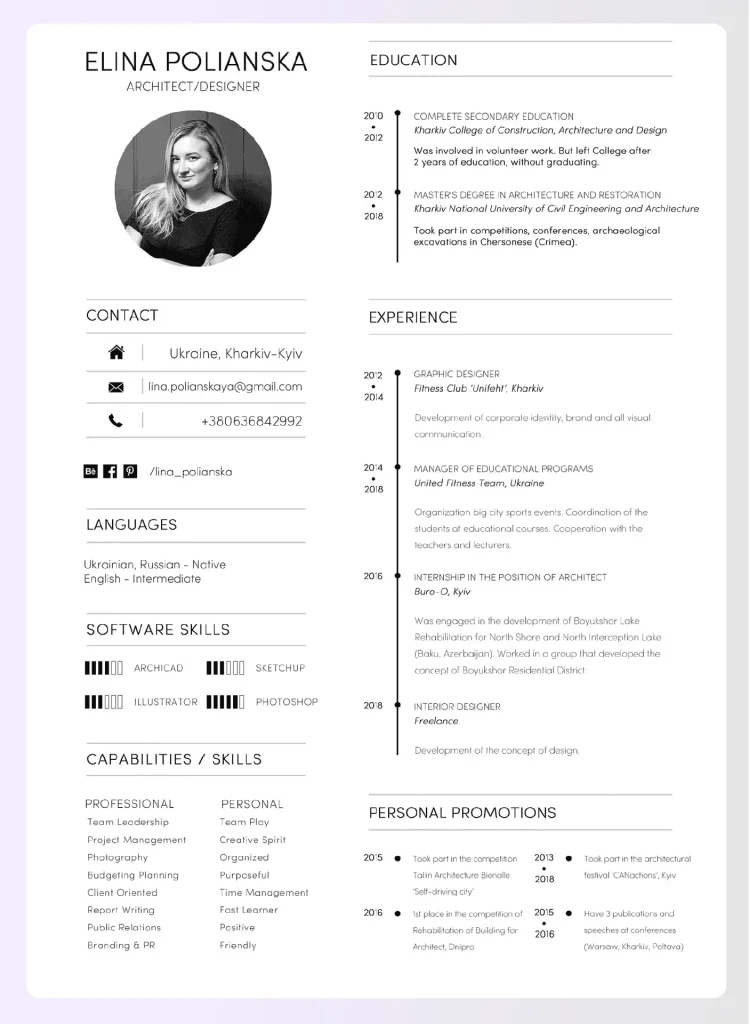
For recent graduates still building their portfolio of professional work, this approach shows you already think like a designer, which is exactly what firms want to see.
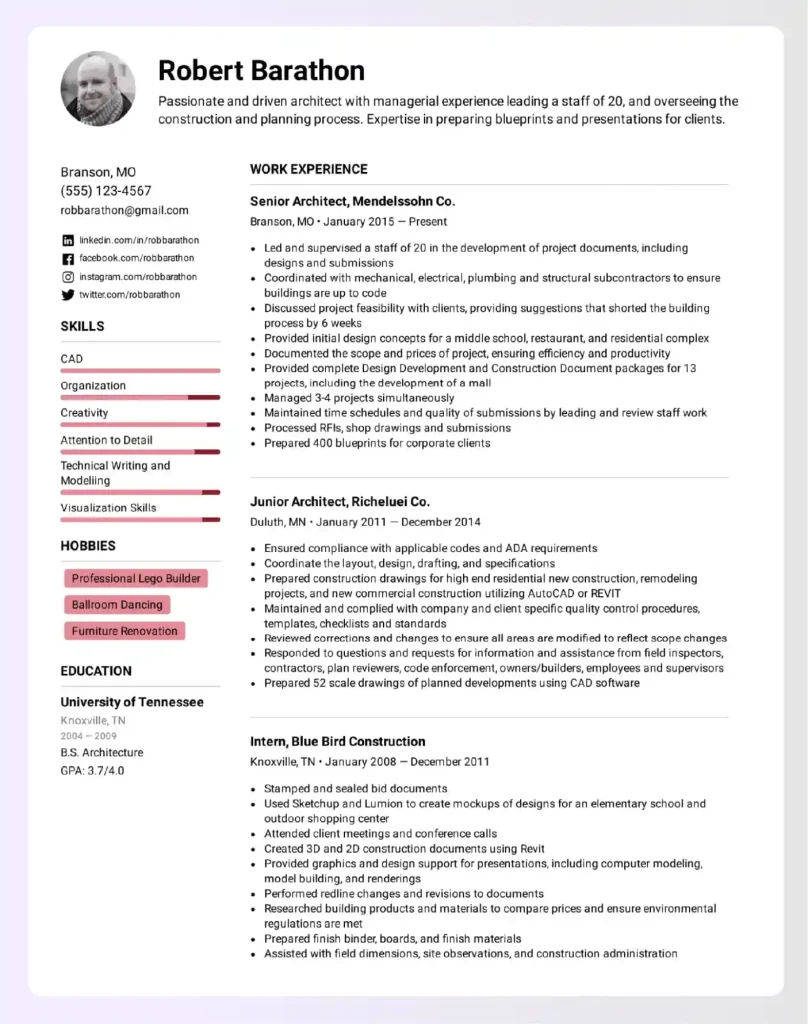
This resume doesn’t just list what you did; it proves the impact you made. That’s what moves you from “maybe” to “let’s interview this person.”
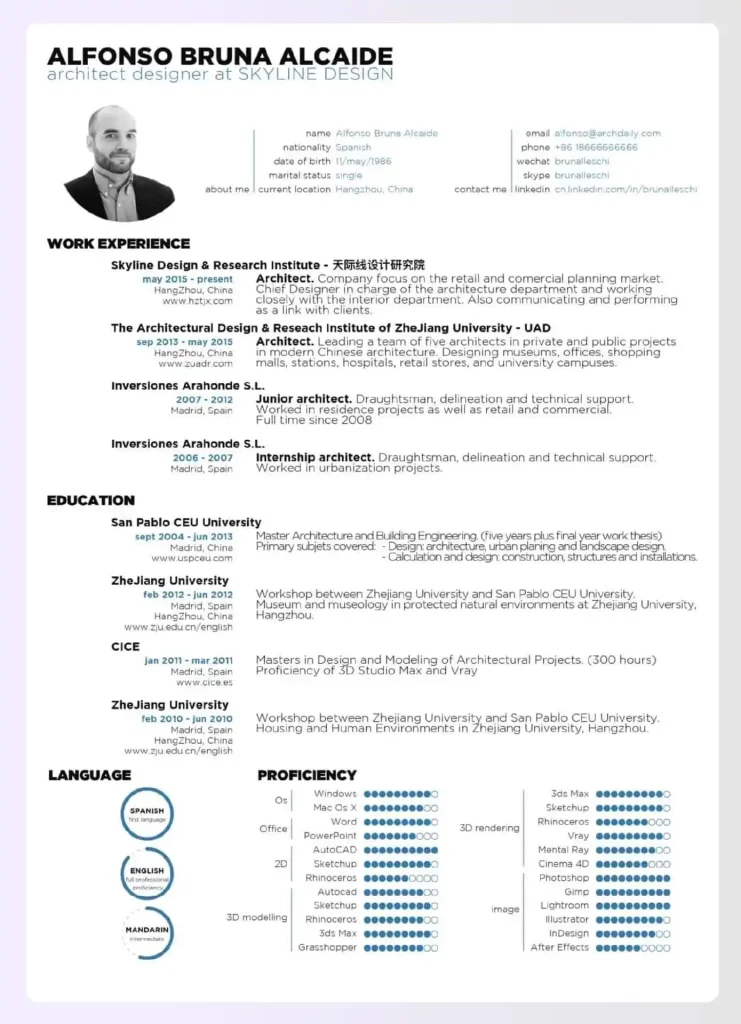
Instead of claiming you’re “proficient in everything,” showing actual skill levels builds credibility with technical hiring managers.
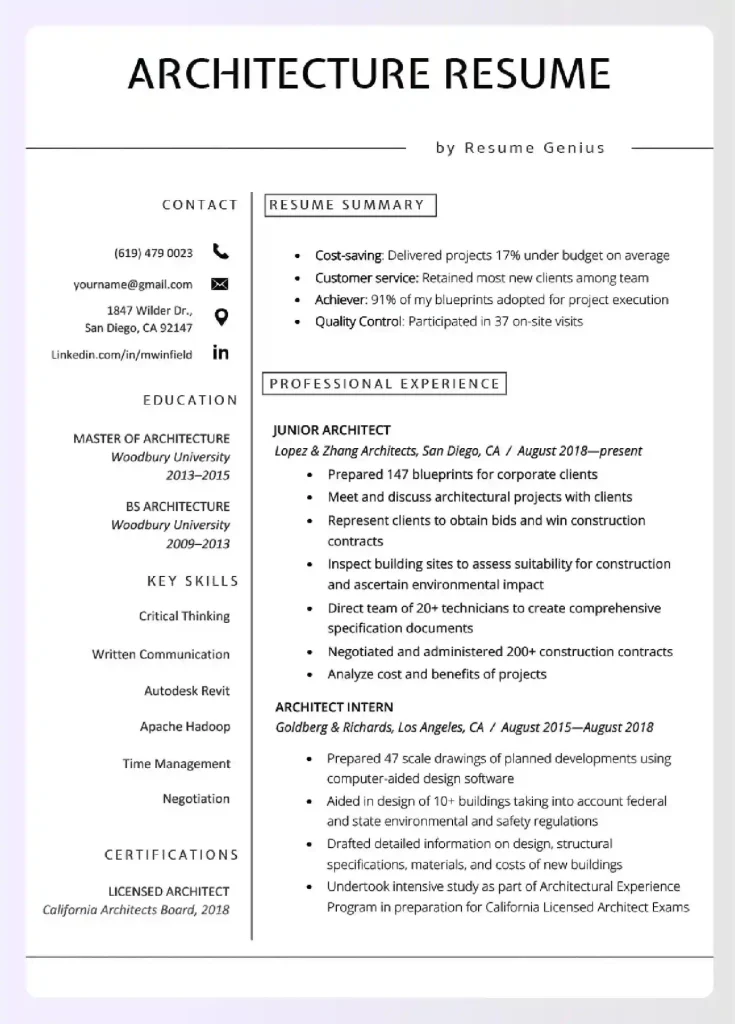
If you’re licensed and want firms to immediately recognize your value, this structure works beautifully.
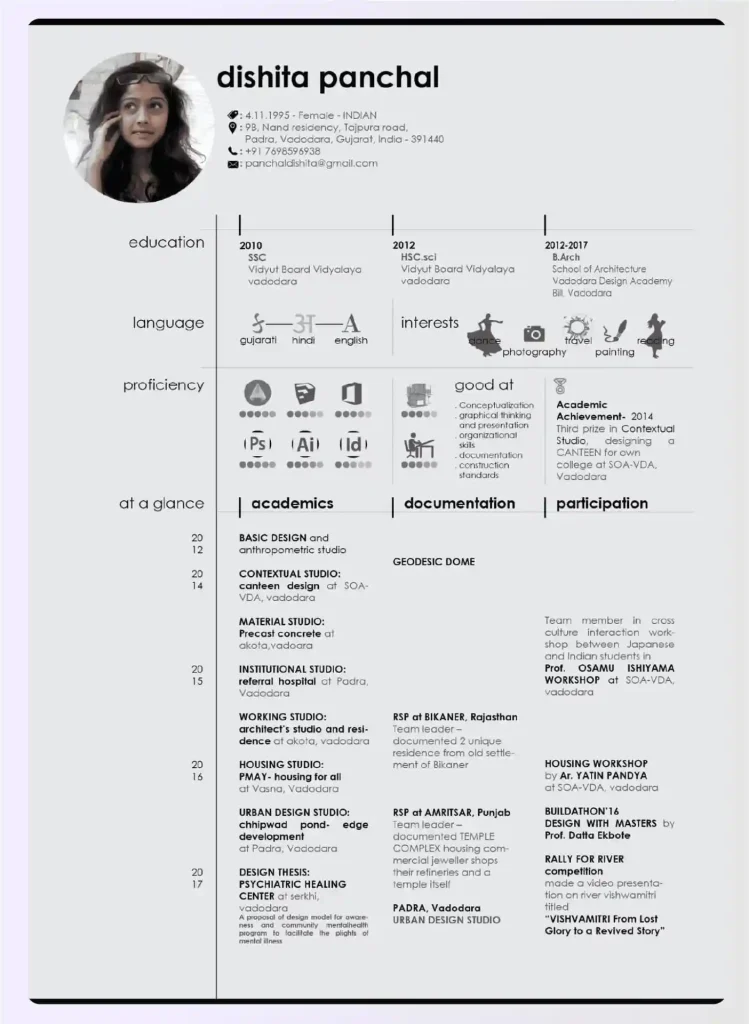
Perfect for showing potential when you can’t yet show a decade of projects.
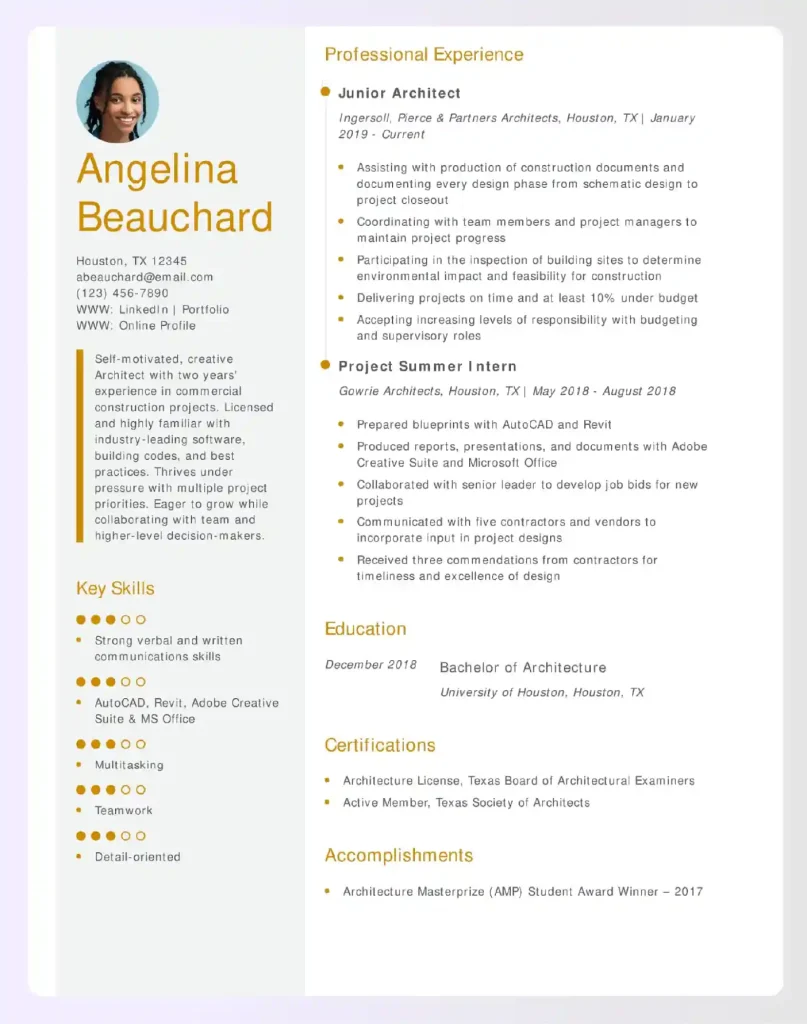
What we like: What works really well here is the honest progression from intern to junior architect. That professional summary sets realistic expectations (“eager to grow while collaborating”) without underselling capabilities. The visual skill indicators show self-awareness: you’re not claiming expert-level Revit skills after 18 months, and that honesty actually builds trust.
This is exactly how early-career architects should position themselves: capable, growing, and transparent.
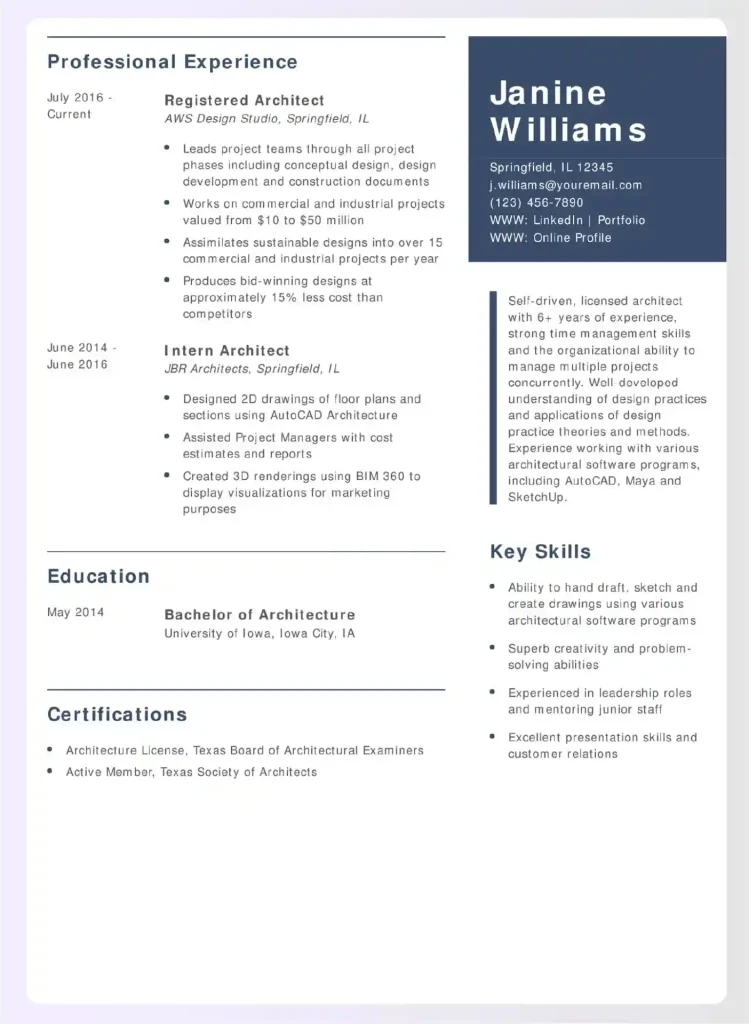
What we like: Once you’re licensed, lead with it, and this resume does exactly that. Those credentials with actual license numbers and dates? They’re front and center where they belong. The work experience clearly shows progression without drowning you in details, and the education section knows its place (important, but not the headline anymore).
This layout is ideal for that sweet spot between junior and senior roles where your license matters more than your thesis.
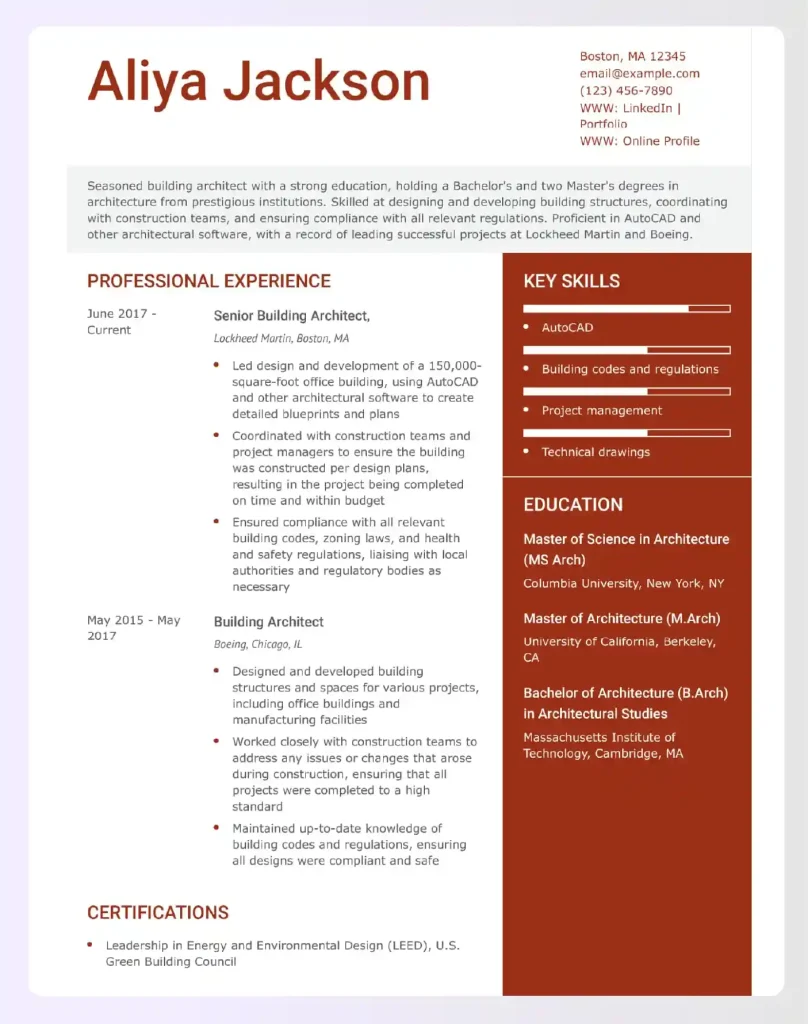
What we like: Managing multiple advanced degrees is tricky: lean too hard on education and you look academic rather than practical. This resume gets the balance right. Three degrees are listed cleanly without dominating, while the experience section leads with real impact: teams managed, projects delivered, problems solved.
That strategic color block adds visual interest without looking gimmicky. This is how senior architects should present themselves: educated, yes, but primarily experienced.
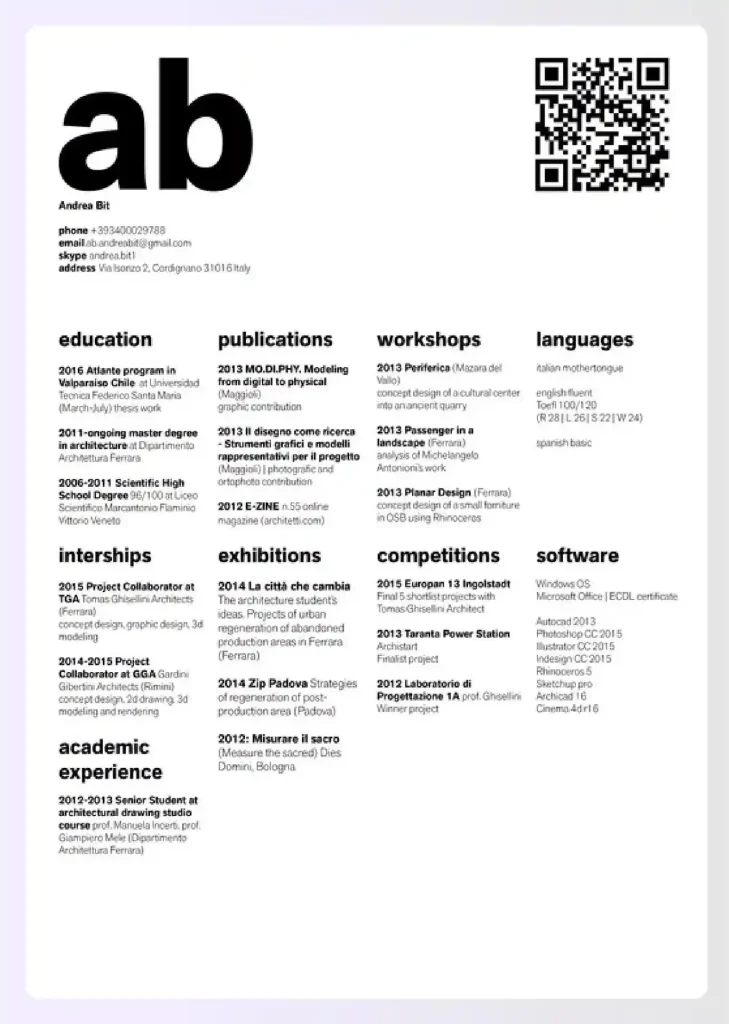
What we like: This one takes risks, and they pay off. That bold typographic logo, the QR code linking directly to portfolio work, the unconventional section organization? It all screams “I’m a designer first.” The comprehensive breakdown of publications, exhibitions, and competitions shows you’re active in the design community beyond just client work.
Fair warning though: this format is perfect for boutique design firms but might confuse more conservative ATS systems. Know your audience.
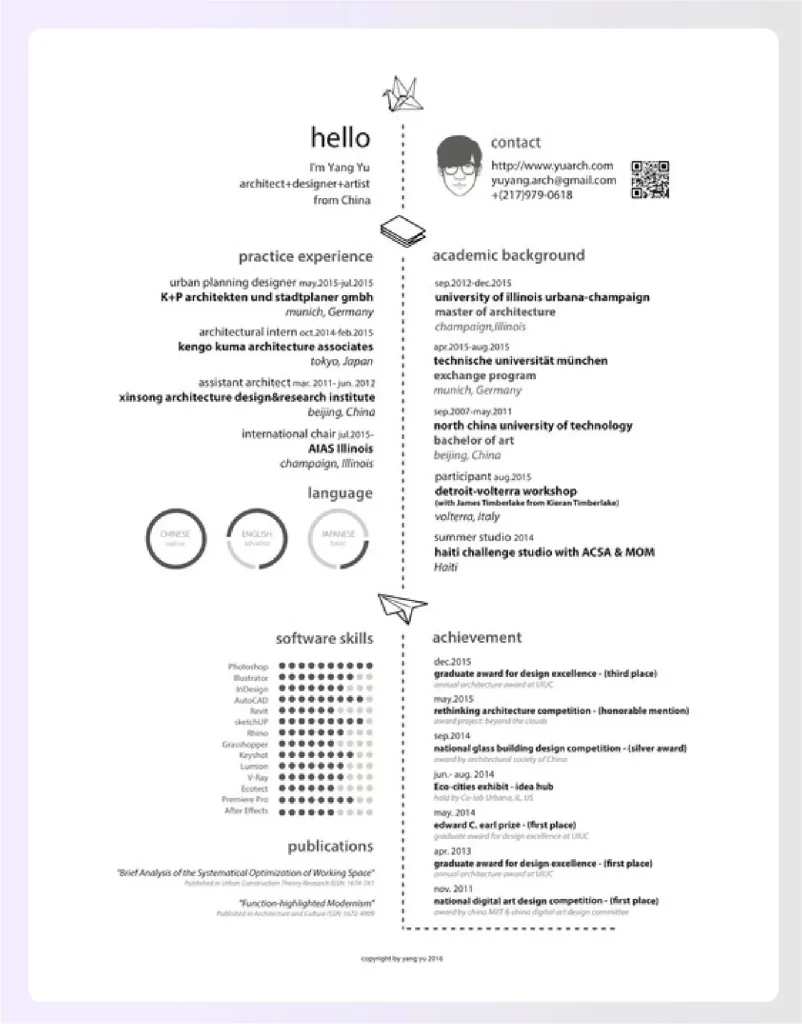
What we like: Sometimes the most sophisticated design is the simplest one. This minimalist layout uses clean lines and strategic white space to create a resume that’s genuinely pleasant to read. Those language proficiency circles and software skill dots? They communicate complex information instantly. And that practice experience spanning Germany, Japan, China, and Spain isn’t just listed; it’s positioned as the differentiator it is.
Perfect for architects targeting international firms or anyone who’s worked across cultures and wants that front and center.
After reviewing these examples, you might be wondering about the ideal length for your own resume.
How Long Should Your Architecture Resume Be?
The right length depends on your experience level. Entry-level architects and recent graduates should aim for one page, mid-career professionals (5-10 years) can use 1-2 pages, and senior architects typically need two pages to adequately cover extensive experience.
Quality always trumps quantity. A concise, impactful resume beats a longer one padded with generic descriptions. To condense without losing impact, adjust margins slightly (minimum 0.5″), remove less impressive bullets, prioritize recent experience, and eliminate redundancy.
Start Building Your Architecture Career Today
Resume writing may seem tedious but if you do it right, you may not have to make another one for the rest of your life. The aim is to seem like an appealing candidate to the architecture firm so they hire you, preferably for life.
As a fresher, you may have some difficulty with the section on work experience. That is no reason to fret though. All you need to do is get a little creative. Consider using the Foyr Neo Software and whip up a few, beautiful architectural plans. Even if it is enlisted as freelance work, the hiring manager may be intrigued enough to request a showing.
Voila! Now you can share your design skills during the interview, thus securing the job position for yourself.
Ready to take your architecture career to the next level? Implement these strategies to create a resume that truly represents your capabilities.
Frequently Asked Questions About Architecture Resumes
1. What are the top 3 skills every architect should list?
Software proficiency (Revit and AutoCAD with specific levels like “Expert in Revit”), construction documentation capabilities (CD sets, consultant coordination, building codes), and project coordination/communication (work with engineers, contractors, clients with specific examples). Specialized skills in sustainable design or emerging technologies like computational design can further differentiate you.
2. Should architects include hobbies on their resume?
Only include hobbies if they’re architecturally relevant (architectural photography, sketching, design-focused travel, woodworking) or demonstrate professional qualities (marathon running shows discipline, team sports show collaboration). Omit generic hobbies and anything taking space better used for qualifications.
3. How do you quantify achievements on an architecture resume?
Use specific metrics: project values ($15M mixed-use development), efficiency gains (reduced timeline by 20%), team size (led 8 team members), and client impact (95% satisfaction rate). Follow the formula: Action Verb + Task + Context + Result.
4. What file format should you use for your architecture resume?
Use PDF in most cases as it preserves formatting and works with modern ATS systems. Use .docx only when specifically requested. Create PDFs using “Save As PDF” from Word or Google Docs, never from design software. Name files professionally: LastName_FirstName_Resume.pdf.
5. How often should you update your architecture resume?
Update every 3-6 months routinely and immediately after major milestones (completed projects, new certifications, promotions, awards). Conduct an annual review to ensure relevant information and maintain multiple versions for different purposes.
6. Should you include a photo on your architecture resume?
Not in the United States due to discrimination concerns and ATS issues. International practices vary. Photos are expected in Germany, France, and many European/Asian countries but not in the UK, Ireland, Canada, or Australia. Instead, use LinkedIn for your professional photo and include the URL on your resume.










Leave A Reply